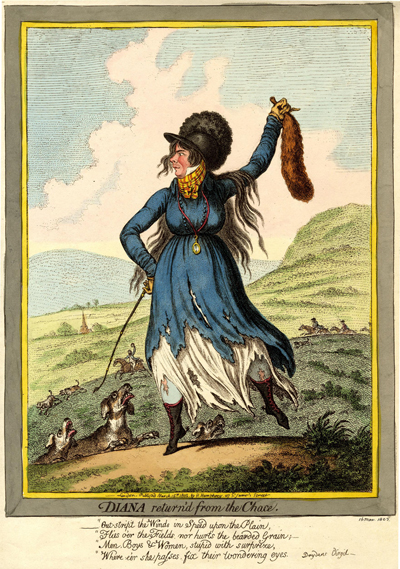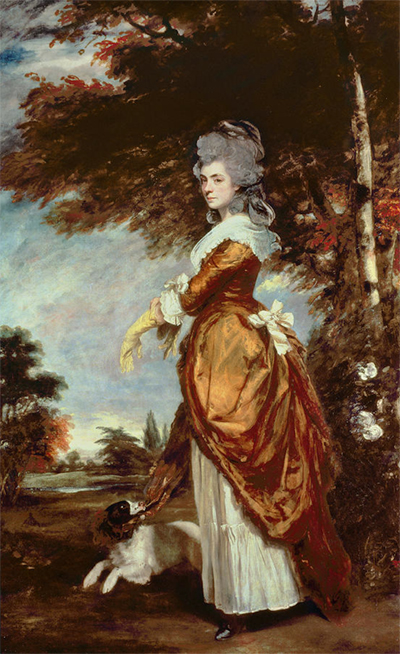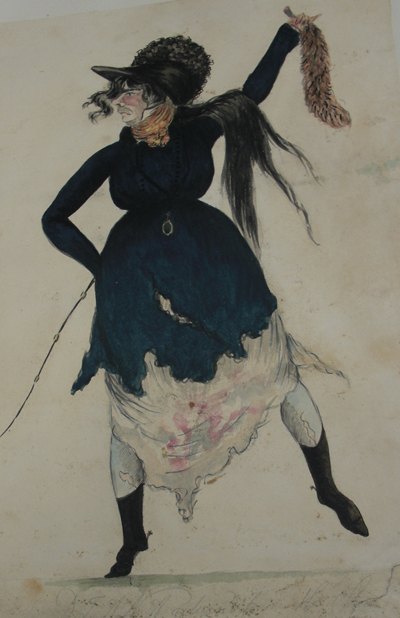Diana Return'd from the Chace
This is a satiric portrait caricature of Lady Emily Mary, Marchioness of Salisbury, who was noted for her eccentric fashion sense (she designed many of her own clothes and cared little about what people thought of them), her love of music, and (most of all) for her devotion to her dogs and the hunt.

©Trustees of the British Museum
Even her formal portrait by Sir Joshua Reynolds in 1780 includes one of her dogs pulling at the hem of her dress as if urging her out of her fancy clothes and back to the chase.

Emily Cecil, 1st Marchioness of Salisbury,
[1780]
©Wikimedia Commons
Gillray's portrait is based upon an amateur watercolour in the British Museum collection with the same title and caption. The title, of course, refers to Diana, the Goddess of the hunt, who is also frequently portrayed with her dogs. The quotation that makes up the caption, however, does not describe Diana, but rather Camilla, a warrior princess raised, like Diana, as a huntress. The four lines excerpted come from the end of Book VII of Dryden's translation of Vergil's Aeneid where Camilla is described.
Last, from the Volscians fair Camilla came,
And led her warlike troops, a warrior dame;
Unbred to spinning, in the loom unskill'd,
She chose the nobler Pallas of the field.
Mix'd with the first, the fierce virago fought,
Sustain'd the toils of arms, the danger sought,
Outstripp'd the winds in speed upon the plain,
Flew o'er the fields, nor hurt the bearded grain:
She swept the seas, and, as she skimm'd along,
Her flying feet unbath'd on billows hung.
Men, boys, and women, stupid with surprise,
Where'er she passes, fix their wond'ring eyes:
Longing they look, and, gaping at the sight,
Devour her o'er and o'er with vast delight;
Gillray, as usual in situations like this, stays close to the original, retaining the pose and the thoroughly tattered dress and stockings of the watercolour. But, most conspicuously, he has added a background with a view of the countryside and the other horsemen winding their way towards the triumphant Lady Salisbury to provide both the natural context for her pose and to reinforce the caption, emphasizing Lady Salisbury's rapidity of movement. (She arrived there first.) In addition to that basic change, Gillray has also made a number of small but subtle improvements: adjusting her two arms and the fall of her hair to make them appear more natural, adding light and more subtle shading to bring out her figure, eliminating her bloody petticoats to make her appearance less brutal, coloring her eyeglass ribbon to render it more visible, and, finally, by eliminating the grey shadows, giving her face a more feminine cast.

[March ?, 1802]
©Trustees of the British Museum
© Photo by Jim Sherry
As the wife of the Marquess of Salisbury, Lord Chamberlain in both the Pitt and Addington ministries, Lady Salisbury was seldom out of the public eye. In the week before this print appeared, for instance, her "Rout" at their residence in Arlington Street was listed in the Morning Post and Gazetteer for March 8, 1802 among the "Fasionable Arrangements for the Week." And in the same newspaper, her presence was noted at "Colonel Greville's Pic-Nic" along with the Earl of Mount Edgcumbe, the Countesses of Aldborough, Chatham, and Edgcumbe, and one hundred other dignitaries.
Notices like these and the commission provided by the amateur watercolorist here may have prompted Gillray to realize that he could use Lady Salisbury as a colorful addition to some prints about the Pic-Nics which began appearing a couple of weeks later.
Sources and Reading
- Commentary from the British Museum on Diana Return'd from the Chace.
- "An Unconventional Marchioness: The Life of Lady Salisbury," All Things Georgian
- "Emily Cecil, Marchioness of Salisbury," Wikipedia
- "James Cecil, 1st Marquess of Salisbury," Wikipedia
- "Diana (mythology)," Wikipedia
- "Camilla (mythology)," Wikipedia
- Thomas Wright and R.H. Evans, Historical and Descriptive Account of the Caricatures of James Gillray #515.
- Thomas Wright and Joseph Grego, The Works of James Gillray, the Caricaturist; With the History of His Life and Times, p. X\290.
Comments & Corrections
NOTE: Comments and/or corrections are always appreciated. To make that easier, I have included a form below that you can use. I promise never to share any of the info provided without your express permission.